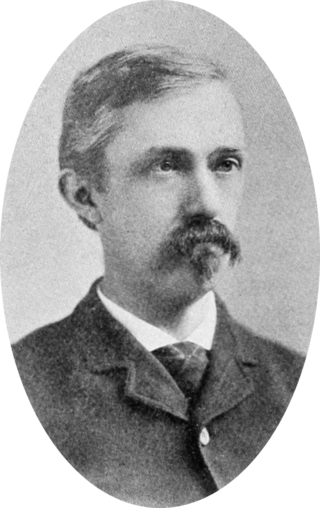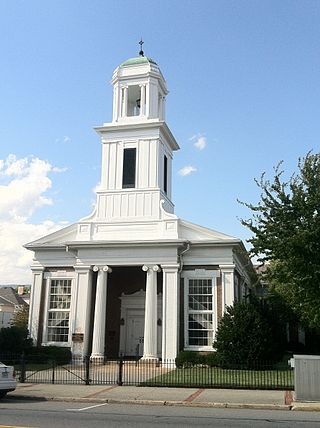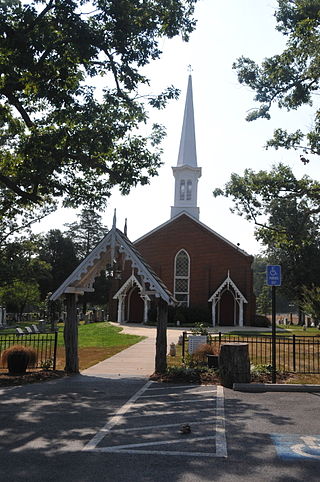
Westminster Hall and Burying Ground is a graveyard and former church located at 519 West Fayette Street in Baltimore, Maryland, United States. It is currently part of the grounds of the University of Maryland's School of Law. It occupies the southeast corner of West Fayette and North Greene Street on the west side of downtown Baltimore. It sits across from the Baltimore VA hospital and is the burial site of Edgar Allan Poe (1809–1849) and several politicians and military officials. The complex was declared a national historic district in 1974.

Robert Lewis Dabney was a Southern Presbyterian pastor and theologian, Confederate army chaplain, and architect from Virginia. He was also chief of staff and biographer to Stonewall Jackson; his biography of Jackson remains in print today.
Samuel Doak (1749–1830) was an American Presbyterian clergyman, Calvinist educator, and a former slave owner in the early movement in the United States for the abolition of slavery.

Samuel Davies was an evangelist and Presbyterian minister. Davies ministered in Hanover County from 1748 to 1759, followed by a term as the fourth President of Princeton University, then known as the College of New Jersey, from 1759 to 1761. Davies was one of the first non-Anglican preachers in Virginia, and one of earliest missionaries to slaves in the Thirteen Colonies. He was a strong advocate for religious freedom, and helped to institute significant religious reforms in the colony. Davies was also a prolific writer, authoring several hymns and publishing a book of poetry. He advocated for providing religious education to slaves.

The National Presbyterian Church is a Christian congregation of approximately 1,500 members of all ages from the greater metropolitan Washington, D.C., area. The mission statement of the church is "Leading People to Become Faithful Followers of Jesus Christ Together in God's World"
Briery is an unincorporated community in Prince Edward County, Virginia, United States.

Buffalo Presbyterian Church is a historic Presbyterian Church located in Pamplin, Prince Edward County, Virginia. Built about 1804, it is a simple frame weather-boarded structure with a gable roof covered with standing seam metal. Early in the 20th century the front of the church was reoriented to the east and, in 1931, an addition was made, consisting of an entrance vestibule flanked on either side by a small classroom. Also on the property is the contributing church cemetery, with a number of stone markers, the earliest of which is dated 1832. The congregation of Buffalo was formed in 1739 and is the earliest extant Presbyterian congregation in Southside Virginia.

The Old Presbyterian Meeting House is a Christian church located at 321 South Fairfax Street in the Old Town neighborhood of Alexandria, Virginia. It is part of the National Capital Presbytery and the Synod of the Mid-Atlantic of the Presbyterian Church (USA).

Floyd Presbyterian Church is a historic Presbyterian church located on U.S. 221 in Floyd, Floyd County, Virginia. It was built in 1850, and is a one-story, three-bay, brick church in the Greek Revival style. It has a front gable roof topped by a low steeple and octagonal spire. The front facade features four white-painted stuccoed, Greek Doric order pilasters. The church was abandoned by its congregation in October, 1974, and the congregation relocated.

Old Stone Church is a historic church at 304 E. Piccadilly Street in Winchester, Virginia.

The Robert Kennedy Memorial Presbyterian Church, also known as the Welsh Run Presbyterian Church, is an historic, American Presbyterian church that is located in Montgomery Township, Franklin County, Pennsylvania.

Byrd Presbyterian Church is a historic Presbyterian church located at Goochland in western Goochland County, Virginia on Dogtown Road. The original building dates from 1838 and is still in active use today. It is a two-story, rectangular brick structure with a slate gable roof. The interior of the church measures 28 feet by 40 feet. Also on the property is a contributing church cemetery with graves dating back to at least the 1850s.

Samuel Lightfoot Flournoy was an American lawyer, politician, and businessperson in the U.S. state of West Virginia. Flournoy served as a state senator representing the 12th Senatorial District in the West Virginia Senate (1885–1890) and served three terms as mayor of Romney, West Virginia. Flournoy unsuccessfully ran as a candidate for the West Virginia Democratic Party gubernatorial nomination in 1900.

George Addison Baxter was an educator, American university administrator, theologian and author. He served as President of Washington and Lee University from 1799 to 1829 and Hampden–Sydney College from 1835 until his death.

Salem Presbyterian Church is a historic Presbyterian church at E. Main and Market Streets in Salem, Virginia. It was built in 1851–1852, and is a Greek Revival style temple form church. It has a slightly projecting Ionic order portico in antis with belfry. The church owned the Salem Presbyterian Parsonage from 1854 to 1941.

Greenwich Presbyterian Church and Cemetery is a historic Presbyterian church and cemetery located at 9510 Burwell Road in Greenwich, Prince William County, Virginia. It was started in 1859, and is a one-story, gable-roofed brick church building in the Gothic Revival style. It features two pointed-arched front doors, decorative buttresses on the side walls, and large, pointed, arched windows on the front and side walls. It has a wooden church tower with a louvred belfry and a shingle-covered spire topped by a weathervane. The adjacent cemetery has at least 100 headstones and includes the graves of several American Civil War soldiers, including Captain Bradford Smith Hoskins, a colorful Englishman who rode with Colonel John S. Mosby.

The Tinkling Spring Presbyterian Church is a Presbyterian church founded in 1740, and is the oldest Presbyterian congregation in the Valley of Virginia. Its historic building is listed on the National Register of Historic Places (NRHP).

Salem Presbyterian Church is a Presbyterian church at 147 Washington College Road at the Washington College Academy in Tennessee. It was started in 1894 and was added to the National Register of Historic Places in 1992.

Longwood House is a historic home located at Farmville, Prince Edward County, Virginia, and functions as the home of the president of Longwood University. It is a 2+1⁄2-story, three-bay, frame dwelling with a gable roof. It features Greek Revival style woodwork and Doric order porch. Longwood House has a central passage, double-pile plan. It has a two-story wing added about 1839, and a second wing added in the 1920s, when the property was purchased by Longwood University. The house is located next to the university golf course, and since 2006, athletic fields used by the Longwood Lancers.

The history of religion in early Virginia begins with the founding of the Virginia Colony, in particular the commencing of Anglican services at Jamestown in 1607. In 1619, the Church of England was made the established church throughout the Colony of Virginia, becoming a dominant religious, cultural, and political force. Throughout the 18th century its power was increasingly challenged by Protestant dissenters and religious movements. Following the American Revolution and political independence from Britain, in 1786 the Virginia Statute for Religious Freedom disestablished the Church of England, ending public support and fully legalizing the public and private practice of other religious traditions.






















